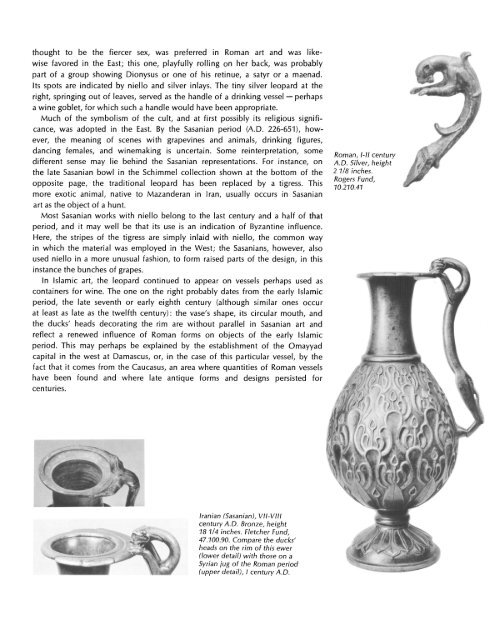The Metropolitan Museum of Art Bulletin, v. 29, no. 7 (March, 1971)
The Metropolitan Museum of Art Bulletin, v. 29, no. 7 (March, 1971)
The Metropolitan Museum of Art Bulletin, v. 29, no. 7 (March, 1971)
You also want an ePaper? Increase the reach of your titles
YUMPU automatically turns print PDFs into web optimized ePapers that Google loves.
thought to be the fiercer sex, was preferred in Roman art and was likewise<br />
favored in the East; this one, playfully rolling on her back, was probably<br />
part <strong>of</strong> a group showing Dionysus or one <strong>of</strong> his retinue, a satyr or a maenad.<br />
Its spots are indicated by niello and silver inlays. <strong>The</strong> tiny silver leopard at the<br />
right, springing out <strong>of</strong> leaves, served as the handle <strong>of</strong> a drinking vessel - perhaps<br />
a wine goblet, for which such a handle would have been appropriate.<br />
Much <strong>of</strong> the symbolism <strong>of</strong> the cult, and at first possibly its religious significance,<br />
was adopted in the East. By the Sasanian period (A.D. 226-651), however,<br />
the meaning <strong>of</strong> scenes with grapevines and animals, drinking figures,<br />
dancing females, and winemaking is uncertain. Some reinterpretation, some<br />
different sense may lie behind the Sasanian representations. For instance, on<br />
the late Sasanian bowl in the Schimmel collection shown at the bottom <strong>of</strong> the<br />
opposite page, the traditional leopard has been replaced by a tigress. This<br />
more exotic animal, native to Mazanderan in Iran, usually occurs in Sasanian<br />
art as the object <strong>of</strong> a hunt.<br />
Most Sasanian works with niello belong to the last century and a half <strong>of</strong> that<br />
period, and it may well be that its use is an indication <strong>of</strong> Byzantine influence.<br />
Here, the stripes <strong>of</strong> the tigress are simply inlaid with niello, the common way<br />
in which the material was employed in the West; the Sasanians, however, also<br />
used niello in a more unusual fashion, to form raised parts <strong>of</strong> the design, in this<br />
instance the bunches <strong>of</strong> grapes.<br />
In Islamic art, the leopard continued to appear on vessels perhaps used as<br />
containers for wine. <strong>The</strong> one on the right probably dates from the early Islamic<br />
period, the late seventh or early eighth century (although similar ones occur<br />
at least as late as the twelfth century): the vase's shape, its circular mouth, and<br />
the ducks' heads decorating the rim are without parallel in Sasanian art and<br />
reflect a renewed influence <strong>of</strong> Roman forms on objects <strong>of</strong> the early Islamic<br />
period. This may perhaps be explained by the establishment <strong>of</strong> the Omayyad<br />
capital in the west at Damascus, or, in the case <strong>of</strong> this particular vessel, by the<br />
fact that it comes from the Caucasus, an area where quantities <strong>of</strong> Roman vessels<br />
have been found and where late antique forms and designs persisted for<br />
centuries.<br />
Roman, 1-11 century<br />
A.D. Silver, height<br />
2 1/8 inches.<br />
Rogers Fund,<br />
10.210.41<br />
Iranian (Sasanian), VII-VIII<br />
century A.D. Bronze, height<br />
18 1/4 inches. Fletcher Fund,<br />
47.100.90. Compare the ducks'<br />
heads on the rim <strong>of</strong> this ewer<br />
(lower detail) with those on a<br />
Syrian jug <strong>of</strong> the Roman period<br />
(upper detail), I century A.D.

















